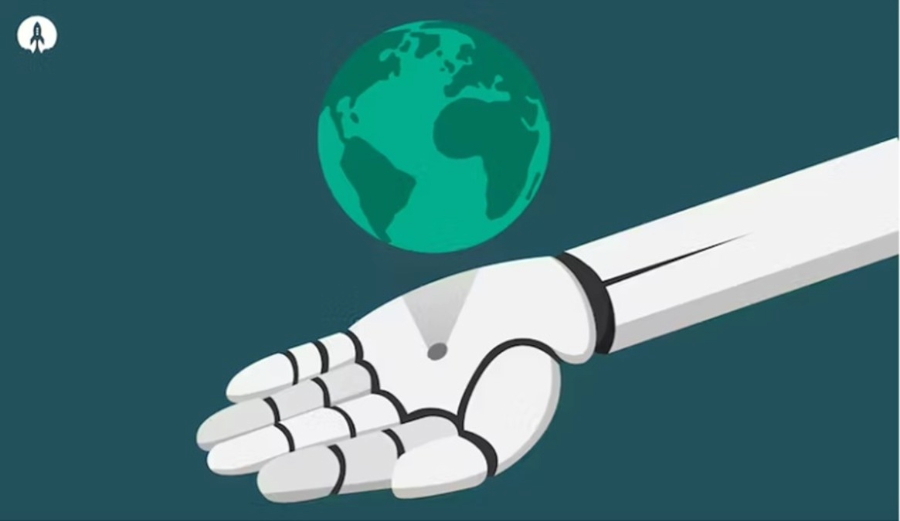Beyond the Hype: Why AI Isn’t Always Sunshine and Rainbows for the Planet
Artificial intelligence (AI) is often portrayed as a magic bullet for our future, solving challenges ranging from healthcare to climate change. While its potential is undeniable, the narrative around AI tends to paint it as a uniformly “green” technology, saving the planet with every algorithm. But the reality is more nuanced. AI holds immense potential for tackling climate change, but its own energy consumption and e-waste pose significant environmental threats. Striking a balance requires careful consideration and action.
Yes, AI can be a powerful tool for sustainability. It can optimize energy grids, predict weather patterns for renewable energy integration, and even design environmentally friendly materials. However, before we get swept away in the green wave of AI hype, let’s acknowledge the elephant in the data center: AI can also be a significant environmental burden.
Multiple studies paint a worrying picture that by 2025, AI’s energy demands could surpass the entire human workforce, jeopardizing our carbon-neutral efforts. This growing appetite could negate hard-won progress in reducing greenhouse gas emissions. Studies estimate that some large language models can emit as much carbon as several cars throughout their lifetime.
However, AI isn’t inherently “green.” Let’s explore its environmental challenges:
Environmental Footprint:
Energy Guzzler: Training and running complex AI models require immense computing power, contributing to high energy consumption and carbon emissions. Training complex AI models releases massive amounts of carbon dioxide, exceeding an average car’s lifetime emissions.
Manufacturing Footprint: Producing specialized AI hardware involves resource extraction and energy-intensive processes, impacting the environment.
E-waste: With rapid advancements, AI hardware becomes obsolete quickly, generating significant electronic waste, which often ends up in landfills, releasing harmful toxins if not disposed of properly. Projected 75 million tonnes of e-waste by 2030, containing harmful toxins like lead and mercury
Ecosystem Risks: Overreliance on AI in agriculture could lead to excessive pesticide use and biodiversity loss.
Beyond the Environment:
Data Concerns: The vast amounts of data needed for AI training raise privacy and security risks. Bias in data can lead to discriminatory outcomes. Large data centres housing AI models can consume vast amounts of energy for cooling and power, further contributing to the carbon footprint.
Job Market Jitters: AI automation may displace workers in sectors like manufacturing and service, potentially exacerbating inequality.
Ethical Considerations: AI systems wielding immense power need ethical development and use, considering transparency, accountability, and safety.
But wait, there’s hope! Just like AI can contribute to environmental problems, it can also be part of the solution. We call this Green AI:
Building a Sustainable AI Future:
Big AI, big energy problem. Businesses must act now to make AI sustainable. Harnessing AI’s potential while mitigating its risks requires proactive steps:
Green AI Practices: Develop and deploy more energy-efficient AI models and hardware. Utilize renewable energy sources. : Focus on renewable energy sources and energy-efficient hardware for AI development.
Responsible Data Management: Prioritize data privacy and security. Address algorithmic bias to ensure fairness and ethical use. Design and train AI models with energy efficiency in mind, prioritizing smaller, faster algorithms.
Reskilling and Upskilling: Prepare individuals for the changing job market through training and skill development programs. Implement robust e-waste collection and recycling systems to minimize environmental impact.
Ethical Guidelines: Establish ethical frameworks for AI development and deployment, considering transparency, accountability, and safety.
Balancing innovation with sustainability: Regulatory and technological approaches to greening AI.
Renewable energy sources: Powering data centres and AI systems with renewable energy sources like solar and wind power can significantly reduce their carbon footprint.
Sustainable data management: Implementing efficient data storage and processing practices can minimize the environmental impact of data used for AI development.
Collaborative Action: Governments, industries, and researchers must work together to develop sustainable AI solutions.
The future of AI isn’t predetermined. We can choose to develop and deploy it responsibly, with a focus on sustainability. By embracing Green AI solutions, we can ensure this powerful technology becomes a force for good, not just for humanity, but for the planet as well. AI’s potential for good remains vast, but addressing its environmental footprint is crucial.
Remember, the next time you hear about AI saving the world, ask yourself: is it truly green, or just greenwashed? Let’s have an honest conversation about AI’s environmental impact and work together to create a future where technology and sustainability go hand in hand. By acknowledging the challenges and adopting sustainable practices, we can ensure AI contributes to a positive future, not undermines our environmental goals.
Open discussions and proactive measures are needed to ensure AI plays a positive role in building a sustainable future.
Source

